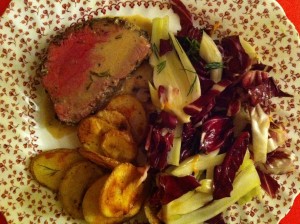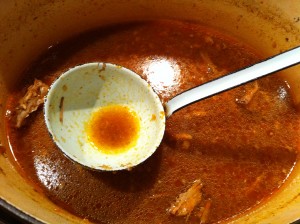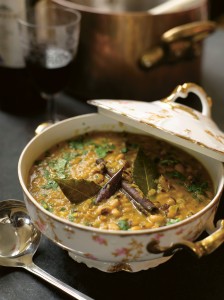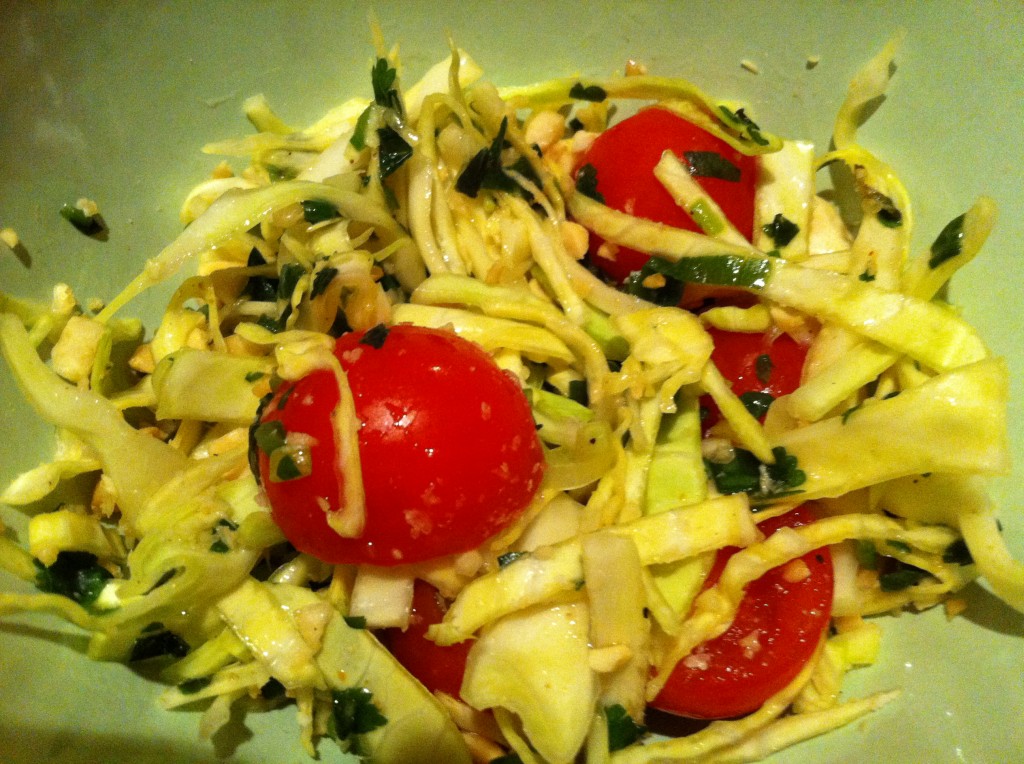Masala Farm—Stories and Recipes from an Uncommon Life in the Country, by Suvir Saran, with Raquel Pelzel and Charlie Burd. Chronicle Books, 2011. Photographs by Ben Fink.
—————-
Allow me to introduce you to a most subjective book review. Incidentally, it also a beginning: it is my very first blog post. I have no idea if I will become a real blogger like some of my very gifted writing colleagues, but here I am writing my first post. And writing is something I love to do.
The book is Masala Farm by lauded Indian-born chef and friend Suvir Saran of Top Chef Masters fame. Masala means spice in Hindi. Suvir wrote this book, his third, together with Raquel Pelzel and his partner Charlie Burd. It was nominated for a James Beard Award this year. If none of Suvir’s books are already on your kitchen shelf, this is an immensely appealing introduction to this magician chef who is able to transform even the most pedestrian fare into a mesmerizing everyday feast. You will understand quickly why his New York restaurant Devi was awarded a Michelin-star, the first Indian restaurant in this country to receive this recognition.
But fear not, each recipe Suvir creates in his gorgeous farmhouse kitchen is highly accessible so that you can cook it up yourself without attending culinary school (which Suvir didn’t either!). That’s why I love this book. And I love it also because it bridges cultures and serves up food that tastes so much better for it. Having been raised in Germany and Greece and having married a Canadian man whose roots are in India—I believe the most inspiring food draws from our own roots as much as from our surroundings. And Suvir does just that on his 67-acre farm in upstate New York where he now lives with Charlie, and which I had the honor of visiting earlier this year.
Beautifully written, divided into four chapters for each season and intertwined with lovely “farm yarn” on both men’s community ties and involvement, Masala Farm is an inspiration for all of us who want to eat more of what the farms around us offer. Summer’s bounty becomes Lemon-infused Peach Preserves (traditional) with ginger and saffron (magical), and Upstate Apple Butter (traditional) with whole cloves, cardamom pods, fennel, anise, and ginger (transformed). Right now, I’m burning to make his rhubarb and raspberry cobbler with creme fraiche. I tagged his panko-crusted farro and mushroom burgers, his port and red-wine infused take on French onion soup, using red onions, yes, and the Garam Masala Roast chicken. I’m afraid I will fall for his “not-so-lean chicken” when Suvir not only adds butter to the spice mixture but also rubs duck or goose fat all over the outside and inside of the bird. And for later this year I tagged a ginger- and cumin-infused Sweet and Sour Butternut Squash. Some of Suvir’s dishes are rich and heaping and flavorful, in an all American way. Other recipes are light yet equally rich in flavor.
I own all three of Suvir’s books, starting with Indian Home Cooking. If you find Indian cooking intimidating, with the huge line-up of spices and sometimes long-winding preparations, this book should be in your library. It is a wonderful introduction to the subcontinent’s food, easily replicable in a home kitchen yet full of complex aromas. Suvir’s second book American Masala transforms American favorites with his spice love. And in Masala Farm, Suvir’s gift and passion for cooking and for his current life on an American farm come full circle. And this is one special farm. Not only are the walls in the farm house colored like a rainbow of Indian spices or masalas, the farm is inhabited by special creatures as well: Suvir and Charlie raise endangered species and those on the “critical list” such as Cayuga green-black ducks and American Buff geese, thirty-six breeds of chicken, two super-cute alpacas that were rejected by breeders, and very rare Leicester Longwood sheep, once brought to the US by presidents Washington and Jefferson.
Suvir and I met by one of life’s magical serendipities—on Twitter— when my own book came out. We connected and he ended up writing one of the most moving blog posts about Ancient Grains for Modern Meals—inspired by my Greek recipe for Bittersweet Koliva which is prepared in memory of the deceased. I made it when my own father died and Suvir wrote the post just after his own father passed away [http://suvirsaran.typepad.com/suvir/2011/06/maria-speck-gives-me-ancient-bittersweet-koliva-to-sweeten-my-days-of-mourning.html]. Since then we have become friends and he has supported me on my whirlwind journey with my first book, including a wonderful invitation to his farm last winter.
If you enjoy creative spice combinations, Masala Farm is your book. Everything I prepared was a memorable feast—no exaggeration. During the holidays, we were mesmerized by his skillfully aromatic yet simple preparation of Masala Chateaubriand. Suvir coats the beef tenderloin in his own dried herb mixture—I used herbes de Provence which worked beautifully. Be sure to use the best-quality meat you can find and don’t skip the “gilded lily whiskey gravy” which truly elevates this meal. I served the remaining slices of beef the next day with a coarse rye polenta whose natural tanginess brought the flavors together in surprising ways, and the gravy tasted even better.
I also prepared Spicy Pulled Pork for a group of friends. Flavored with cumin, coriander, red chiles, cinnamon, cloves, cardamom and turmeric, this is a carnivore’s dream of complex and complementary flavors that will leave you licking your plate. Everyone went for seconds, which leads to my only complaint: no leftovers. Next time I will make double the amount. Suvir suggests serving the pork with cornbread, in quesadillas with pico de gallo and guacamole, or layered with basmati rice. I chose brown basmati rice, with a few whole cardamom pods tossed in, which worked beautifully. I also put a bowl of his Cabbage Slaw with Fresh Herbs and Peanuts on the table that night. Beautifully spiced with fresh ginger, lime, toasted cumin, and cayenne, this crisp and juicy slaw gets an unusual twist with loads of fresh scallions, cherry tomatoes, cilantro, fresh mint, and topped with crunchy peanuts. Trust me you won’t miss the mayo. Here, too, be sure to make double the recipe so you won’t cry if there are no leftovers.
I would like to leave you with a simple stew from this magician’s cookbook. It is the New Year’s Black-eyed Pea Curry. I could eat it year-round. Just smelling the layers of spices as you add them to the pot will make you stop in your tracks, and never leave the side of the stove. Don’t let the long list of ingredients deter you—the stew comes together effortlessly. Each time you add a new mixture of spices you will be hovering with your nose over the rim of the pot—and the result is a divine and richly aromatic bean stew probably resembling little you’ve tasted before.
——————————————-
New Year’s Black-Eyed Pea Curry
Serves 6
Throughout the Southern states of America, black-eyed peas are served for good luck on New Year’s Day. They’re excellent with stir-fried cabbage—also considered a good-luck food, since it supposedly represents folded currency—and rice, of course (in the South, this dish would be called Hoppin’ John). In India, my family’s recipe for rongee, Hindi for “black-eyed peas,” is just as tasty. I often make it for our grand New Year’s Eve celebration, happily knowing that the dish will probably be outshined by its fancier table competition, like crown roast of pork, Masala Chateaubriand, or a biryani rice dish. We pull out the good china and the sparkling stemware, load the wine cabinet with bubbly, and trim the house with glittering baubles, like three-foot-tall glass hurricanes filled with beautiful colored glass and twinkling holiday lights strung around the mantle and into antique bird cages. Our holiday tree (purchased from a nearby farm) is lavished with ornaments collected from around the world. It is a night we all look forward to with great anticipation all year long, and any leftovers make New Year’s Day that much tastier!
1/4 cup/60 ml canola or grapeseed oil
8 whole green cardamom pods
6 whole cloves
3 whole dried red chiles
2 bay leaves
1-inch/2.5-cm cinnamon stick
1/2 tsp freshly ground black pepper
1/2 tsp whole cumin seeds
1 1/2-inch/4-cm piece fresh ginger, peeled and grated
1 large red onion, finely chopped
1 tbsp kosher salt plus extra if needed
3 medium tomatoes, quartered
2 garlic cloves, finely minced or pressed through a garlic press
1 tbsp ground coriander
1 tsp ground cumin
1 tsp ground turmeric
1/2 tsp cayenne pepper
1/4 cup/60 ml plain yogurt
Three 15 1/2-oz/445-g cans black-eyed peas, rinsed and drained
1/2 tsp Garam Masala (I used store-bought)
1 cup/240 ml water
Heat the canola oil with the cardamom, cloves, chiles, bay leaves, cinnamon, pepper, and cumin seeds in a large heavy-bottomed pot over medium-high heat until the spices are fragrant, 1 to 2 minutes. Stir in the ginger and cook until it becomes fragrant and sticky, about 1 minute. Add the onion and salt and cook, stirring often, until the onion turns deeply browned and sticky, 15 to 20 minutes. If the onion begins to stick to the bottom of the pot or begins to burn, reduce the heat to medium and splash the pan with a few tablespoons of water, scraping up the browned bits and stirring them into the onion.
While the onion browns, place the tomatoes in a blender or food processor and purée until they are completely smooth. Set aside.
Stir the garlic into the onion mixture and cook until fragrant, 30 seconds to 1 minute. Add the coriander, ground cumin, and turmeric, cooking until they begin to smell toasty, about 30 seconds. Stir in the cayenne pepper and 2 tbsp of the yogurt. Cook until heated through, about 1 minute, and then add the remaining yogurt. Continue to stir and cook the yogurt and spices until the contents of the pot are thick and sticky and the liquid from the yogurt has evaporated, about 2 minutes. Stir in the tomato purée and bring to a boil. Reduce the heat to medium-low and cook until a film of oil pools on the surface of the sauce, 6 to 8 minutes.
Stir the black-eyed peas, garam masala, and water into the tomato mixture. Increase the heat to medium and cook, stirring often, until a bubble or two breaks at the surface, 5 to 7 minutes. Season with salt and serve hot.
———————————–
If a bean stew in early summer is not your thing, be sure to try this refreshing slaw.
Cabbage Slaw with Fresh Herbs and Peanuts
Serves 6 to 8
Made with absolutely no oil or mayonnaise, we make this tangy-spicy-crunchy-herby slaw year-round, but it’s especially great as a picnic salad in the summertime. It’s quite nice with heavy summer fare like fried chicken and barbecue.
A ¾-inch piece fresh ginger, peeled and grated
Juice of ½ lime
1 ½ tsp citrus vinegar or white wine vinegar
1 ½ tsp sugar
¾ tsp chaat masala (I didn’t have any on hand which was just fine)
¼ tsp Toasted Cumin (please see separate recipe)
Pinch of cayenne pepper
2 tsp kosher salt
¼ tsp ground peppercorns
9 scallions, thinly sliced
1 jalapeño (seeded and veined for less heat), finely chopped (optional)
1 pint cherry or grape tomatoes, halved
½ cup finely chopped fresh cilantro
2 tbsp finely chopped fresh mint leaves
½ head green cabbage, halved, cored, and finely sliced
¾ cup chopped roasted peanuts
In a large bowl, whisk together the ginger, lime juice, vinegar, sugar, chaat masala, toasted cumin, cayenne, salt, and peppercorns. Add the scallions, jalapeño, tomatoes, cilantro, and mint leaves and toss to combine. Add the cabbage and toss with your hands, making sure to coat it thoroughly with the other ingredients. Sprinkle with the peanuts and serve immediately, or cover with plastic wrap and refrigerate for up to 4 hours, sprinkling with the peanut just before serving.
Toasted Cumin
Keep a small container of toasted cumin in your spice cabinet at all times. It adds a beautiful nuttiness to everything from vegetables to chili, guacamole, and spice rubs.
1/2 cup/8 g cumin seeds
Place the cumin seeds in a large frying pan over medium heat. Toast, shaking the pan often, until the cumin turns brown and fragrant, about 5 minutes. Turn off the heat and transfer the seeds to a large plate to cool. Once cool, grind in a spice grinder to a fine powder. Store in an airtight container in a cool, dark, dry spot for up to 4 months.
Reprinted with permission from Masala Farm by Suvir Saran, copyright © 2011. Published by Chronicle Books.









20 Responses to Book Review